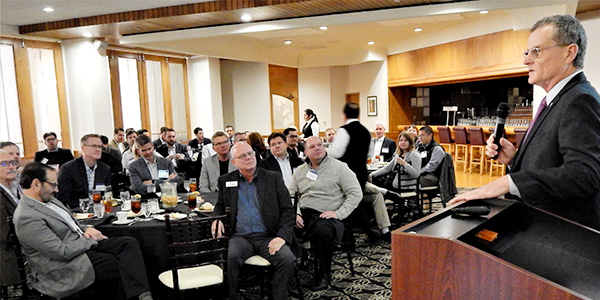By Tom Kleckner
HOUSTON — ERCOT CEO Bill Magness says utility-scale solar “is the next big thing coming at us from the supply side,” giving the ISO just one more challenge to consider.
Noting that solar and wind generation generally complement each other, Magness told a recent Gulf Coast Power Association luncheon that solar “tends to fill the gap during the [late-morning, low-wind hours as load ramps up] … before coastal wind picks up later in the afternoon.”
“[Solar] will continue to accentuate the challenge other types of resources find in having to run economically,” Magness said. “It’s an interesting challenge as we go forward.”
Solar was expected to provide nearly 2 GW of capacity to meet ERCOT demand this winter, but the ISO’s interconnection queue tells a different story for the future. There, 32.2 GW of solar projects are in various stages of the study process, nearly equal to the 40.2 GW of wind projects under study. Together, solar and wind account for 86.8% of the 83.4 GW of the proposed projects in the queue (wind is providing almost 22 GW of capacity this winter).
“It’s all gas, wind and solar. There are no other resources coming along,” Magness said. None of the 1.8 GW of battery storage resources in the queue have a signed interconnection agreement.
“Our solar is very different from [that of] California. California has a lot of solar, but it’s primarily rooftop,” he said. “We’ve seen the real growth in utility-scale. Rooftop is coming, but the big chunks are coming on the utility side.”
ERCOT projects it could have as much as 5 GW of solar energy on the system by 2021, as developers continue to take advantage of the expiring tax credits. Most of those projects have been sited in West Texas, where the irradiance is best.
“As wide an expanse as Texas is, east to west, it’s a different picture in how solar will react than in California,” Magness said. “We’re having to do a lot of work figuring these things out, just as we did with wind.”
He said staff will have to start forecasting solar energy, as they did with wind.
“It was something we didn’t really need to do,” Magness said. “There was never a need to forecast generation. You turned it on, you turned it off. We’re getting better and better with the use of those tools.”
Also of concern to ERCOT is the growth of distributed energy resources (DERs), which can include gas or diesel technologies and storage assets, all connected to the distribution system. The ISO has seen a growth rate of 62% in DERs over the last three years, although the current grand total is only about 1.3 GW of capacity.
“For ERCOT, it’s a question of visibility,” Magness said. “If we don’t know it’s out there, we can’t get it in the system model.”
Staff has spent considerable time recently working with transmission and distribution providers to map some of the 93 existing registered DERs and to map all registered DERs to the system load. The goal is to capture the DERs’ capabilities and capacity “to where they make sense in the models.”
“If you have generation that runs on the system and wants be in the market, you want it to run in the right time and at the right place,” Magness said. “We welcome megawatts of all kinds. We’re just being sure we’re able to see [DERs] and they send the right price signals to make the most effective market.”
He pointed to ERCOT’s performance in the face of slim reserve margins this summer, when it met record demand multiple times without having to take emergency measures or call on additional resources, as an example of the energy-only market’s effectiveness. (See ERCOT SHs Debate Need for Changes Following Summer.)
“Most of the capacity we saw was self-committed. We didn’t need to intervene that many days,” Magness said. “The incentives in the energy-only market are aligned when you keep running in the peak season. We saw the energy-only market work as designed.”






